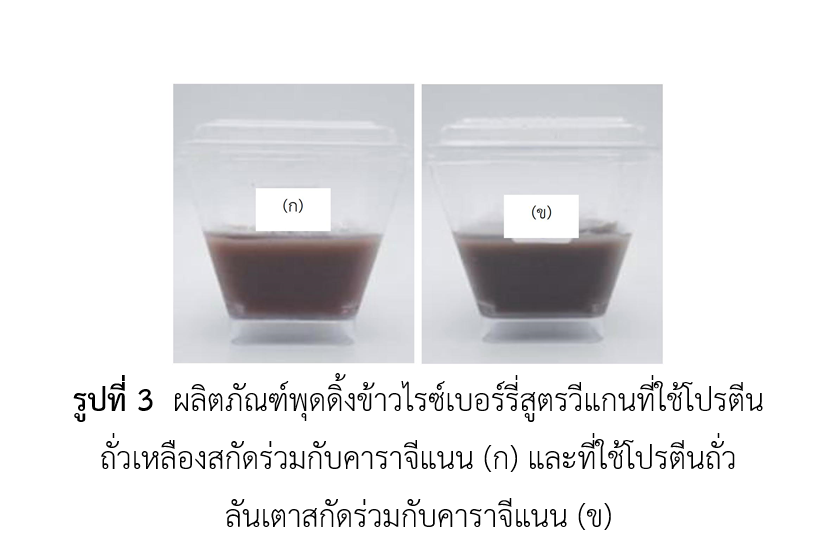การพัฒนาผลิตภัณฑ์พุดดิ้งข้าวไรซ์เบอร์รี่สูตรวีแกน
Main Article Content
บทคัดย่อ
งานวิจัยนี้มีวัตถุประสงค์เพื่อพัฒนาผลิตภัณฑ์พุดดิ้งข้าวไรซ์เบอร์รี่สูตรวีแกน ได้แก่ สูตรโปรตีนถั่วเหลืองสกัด (SPI) และสูตรโปรตีนถั่วลันเตาสกัด (PPI) โดยเบื้องต้นได้ทำการแปรปริมาณโปรตีนสกัดที่ใช้เป็นสารให้ความคงตัว (ร้อยละ 1.0 และ 1.5) และปริมาณคาราจีแนนเป็นสารก่อเจล (ร้อยละ 0.6 และ 0.8) เพื่อนำไปวิเคราะห์และคัดเลือกสูตรที่ได้รับคะแนนการยอมรับสูงและมีการสูญเสียน้ำระหว่างแช่เย็นต่ำ พบว่าสูตรที่คัดเลือกจำนวน 2 สูตร ประกอบด้วยโปรตีนสกัดและคาราจีแนน เท่ากับ ร้อยละ 1.5 และ 0.6 ตามลำดับ และประกอบด้วยน้ำนมข้าวไรซ์เบอร์รี่ น้ำและน้ำตาล ร้อยละ 50 40.9 และ 7 ตามลำดับ และผลการศึกษาคุณภาพต่างๆ พบว่าพุดดิ้งสูตร SPI และ PPI ที่พัฒนาขึ้น ได้รับคะแนนการยอมรับด้านสี รสชาติโดยรวม รสหวาน กลิ่นข้าว กลิ่นถั่ว ความเนียน ความเด้ง และความชอบโดยรวม จาก 9 คะแนน อยู่ในระดับ 6.80±0.95 ถึง 7.45±0.88 และระดับ 6.70±0.92 ถึง 7.10±0.85 คะแนน ตามลำดับ โดยมีค่าการสูญเสียน้ำระหว่างแช่เย็นอยู่ในช่วงร้อยละ 1.08-1.47 และองค์ประกอบทางเคมีต่างๆ ไม่แตกต่างกันอย่างมีนัยสำคัญ (p>0.05) ซึ่งพบแอนโทไซยานินชนิดไซยานิดิน-3-กลูโคไซด์และเพลาร์โกนิดิน-3-กลูโคไซด์ ปริมาณ 0.17 และ 0.09 มิลลิกรัม/100 มิลลิลิตร ตามลำดับ ในพุดดิ้งสูตร SPI ขณะที่พุดดิ้งสูตร PPI มีอยู่ 1.28 และ 0.68 มิลลิกรัม/100 มิลลิลิตร ตามลำดับ ส่วนจำนวนจุลินทรีย์ทั้งหมดอยู่ในเกณฑ์ไม่เกินมาตรฐานผลิตภัณฑ์ชุมชนสำหรับเต้าหู้นมสดคือไม่เกิน 5x104 โคโลนีต่ออาหาร 1 กรัม ขณะที่ลักษณะเนื้อสัมผัสของพุดดิ้งที่แสดงถึงความคงตัวของผลิตภัณฑ์ ได้แก่ ความแข็งของพุดดิ้งสูตร SPI มีค่ามากกว่าสูตร PPI (p<0.05) ในขณะที่ความยืดหยุ่น ความเหนียวและความต้านทานการเคี้ยวได้ของพุดดิ้งสูตร PPI สูงกว่าสูตร SPI (p<0.05) อย่างไรก็ตามความแตกต่างด้านเนื้อสัมผัสจะเป็นการเพิ่มทางเลือกตามความต้องการของผู้บริโภค
Article Details

อนุญาตภายใต้เงื่อนไข Creative Commons Attribution-NonCommercial-NoDerivatives 4.0 International License.
เอกสารอ้างอิง
C. Alamprese and M. Mariott, “Effects of different milk substitutes on pasting, rheologicaland textural properties of puddings,” LWT Food Science and Technology, vol. 44, no. 10, pp. 2019-2025, Dec, 2011.
M.G. Sajilata and R.S. Singhal. “Specialty starches for snack foods.” Carbohydrate Polymers, vol. 59, no. 2, pp. 131-151, Jan. 2005.
H.S. Lim and G. Narsimhan, “Pasting and rheological behavior of soy protein-based pudding,” LWT Food Science and Technology, vol. 39, no. 4, pp. 343-349, May. 2006
Bakery (No Bake), Maeban Co. Ltd., Bangkok, 2011, pp. 40-41.
Chinese Sweets, Maeban Co. Ltd., Bangkok, 2012, pp. 102-103.
A. Mehraj and S. Benjakul. “Impact of legume seed extracts on degradation and functional properties of gelatin from unicorn leather jacket skin,” Process Biochemistry, vol. 46, no. 10, pp. 2021-2029, Oct, 2011
P.A. Spagnuolo, D.G. Dalgleish, H.D. Goff, and E.R. Morris, “Kappa- carrageenan interactions in systems containing casein micelles and polysaccharide stabilizers,” Food Hydrocolloids, vol. 19. No. 3, pp. 371-377, May. 2005.
D. Verbeken, K. Bael, O. Thas, and K. Dewettinck, “Interactions between K-carrageenan, milk proteins and modified starch in sterilized dairy desserts,” International Dairy Journal, vol. 16, no. 5, pp. 482-488, May. 2006
R. Marsili, “Protein power: Functionality and versatility”, Food Product Design, pp. 67-80, Sept., 1993.
M. Petracci, M. Bianchi, S. Mudalal and C. Cavani, “Functional ingredients for poultry meat products,” Trends in Food Science & Technology, vol. 33, no. 1, pp. 27-39, 2013.
Zhang, S., Huang, W., Feizollahi, E., Roopesh, M. S., & Chen, L. Improvement of pea protein gelation at reduced temperature by atmospheric cold plasma and the gelling mechanism study. Innovative Food Science & Emerging Technologies, 67, 102567, 2021
พิมพ์เพ็ญ พรเฉลิมพงศ์ และ นิธิยา รัตนาปนนท์. (2543). Soy protein/โปรตีนถั่วเหลือง [ออนไลน์]. สืบค้นจาก http://www.foodnetworksolution.com/wiki/word/2036/soy-protein- โปรตีนถั่วเหลือง (สืบค้นเมื่อ 5 มกราคม 2565)
Karim, A. A., & Rajeev, B. “Gelatin alternatives for the food industry: recent developments, challenges and prospects,” Trends in Food Science & Technology, vol. 19, no. 12, pp. 644-656, Dec. 2008.
ชมดาว สิกขะมณฑล และ ศิริพร ตันจอ, KU สร้างสรรค์ข้าวไทย ศาสตร์แห่งแผ่นดิน เพื่อความกินดีอยู่ดี, มหาวิทยาลัยเกษตรศาสตร์: สถาบันวิจัยและพัฒนาแห่งมหาวิทยาลัยเกษตรศาสตร์, 2560.
S. Thomasset, N. Teller, & H. Cai, “Do anthocyanins and anthocyanidins, cancer chemopreventive pigments in the diet, merit development as potential drugs?,” Cancer Chemother Pharmacol, vol. 64, no. 1, pp. 201-211, Jun. 2009.
H. Shimoda, M. Aitani, and J. Tanaka, “Purple rice extract exhibits preventive activities on experimental diabetes models and human subject,” Journal of Rice Research, vol. 3, no. 2, pp. 137, Feb. 2015.
จีระศักดิ์ คำสุริย์, เมธาวี ชุณหวุฒิยานนท์ และดุจเดือน บุญสม. รายงานฉบับสมบูรณ์ (Final Report) โครงการศึกษาตลาดอาหารวีแกนเพื่อรองรับการพัฒนาอุตสาหกรรมอาหารของไทย ภายใต้โครงการพัฒนาศูนย์อัจฉริยะสารสนเทศอัจฉริยะอุตสาหกรรมอาหาร ปี2562. กรุงเทพฯ: สถาบันอาหาร กระทรวงอุตสาหกรรม, 2562
พนิตตรา ชำนาญศิลป์ และอารยา อารมณ์ฤทธิ์, “การเปลี่ยนแปลงระดับการสุก ปริมาณแกมมาโอไรซานอล และกิจกรรมการต้านออกซิเดชันของข้าวมีสีหลังจากการให้ความร้อน,” ใน รายงานสืบเนื่องจากการประชุมเสนอผลงานวิจัยระดับบัณฑิตศึกษา ครั้งที่ 12, 28 มกราคม 2554, หน้า 750-756
สุนันทา ประจำ, “ปฏิสัมพันธ์ของโปรตีนนม โพลีแซคคาไรด์ และสารเพิ่มความคงตัวทางการค้าในการพัฒนาพุดดิ้งข้าวหอมมะลิ,”. วิทยานิพนธ์ วท.บ. (เทคโนโลยีอาหาร), มหาวิทยาลัยเทคโนโลยีสุรนารี, นครราชสีมา, 2558.
I.V.E. Chamber and M.B. Wolf, Sensory Testing Methods, 2nd ed, Philadelphia: American Society for Testing and Materials, 1996.
K.O. Honikel, “Reference methods for the assessment of physical characteristics of meat,” Meat Science, vol. 49, no. 4, pp. 447-457, Aug. 1998.
Official Method of Analysis; Association of Official Analytical Chemist (AOAC), 18th Ed., Washington D.C., 2005.
S. Charoenkiatkul, K. Judprasong and P. Thiyajai, “Nutrients and bioactive compounds in popular and indigenous durian,” Food Chemistry, vol. 193, pp. 181-186, Feb. 2016.
R.E. Wrolstad, “Color and pigment analyses in fruit products,” Oregon Agricultural Experiment Station Bulletin, vol. 624, pp. 1-17, 1976.
Bacteriological Analytical Manual (BAM) Online Edition 2001 (US-FDA) [Online]. http://www.cfsan.fda.gov/~ebam/bam-3.html. (Accessed: Feb. 20, 2019).
S. Samard and G.H. Ryu, “Physicochemical and functional characteristics of plant protein-based meat analogs,” Journal of Food Processing and Preservation, vol. 43, no. 10, e14123, Oct. 2019.
J. Giese, “Proteins as ingredients: Types, functions, applications,” Journal of Food Science and Technology, vol. 48, no. 10, pp. 50-60, Dec. 1994.
N. Babault, C. Paizis, G. Deley, G.L. Deremaux, H.M. Saniez, L.C. Millot and A.F. Allaert, “Pea proteins oral supplementation promotes muscle thickness gain during resistance training: a double-blind, randomized, placebo-controlled clinical trial vs whey protein,” Journal of the International Society of Sports Nutrition, vol. 12, no. 3, pp. 1-9, Dec. 2015.
K. Anukulwattana, K. Srinual and A. Halee, “Effects of processing, storage and reheating on the amounts and capacities of the antioxidants of ready-to-eat rice in retort pouch,” KMUTT Research and Development Journal, vol. 41, no. 3, pp. 299-309, Jul. 2018.
Jiang, T., Shuai, X., Li, J., Yang, N., Deng, L., Li, S., ... & He, J. Protein-bound anthocyanin compounds of purple sweet potato ameliorate hyperglycemia by regulating hepatic glucose metabolism in high-fat diet/streptozotocin-induced diabetic mice. Journal of agricultural and food chemistry, 68(6), 1596-1608, 2020.
Liao, M., Chen, F., Hu, X., Liao, X., Miao, S., Ma, L., & Ji, J. Controlled gastrointestinal digestion of micellar casein loaded anthocyanins: The chelating and complexing effect of dextran sulfate. Food Hydrocolloids, 132, 107863, 2022
มาตรฐานผลิตภัณฑ์ชุมชนเต้าหู้นมสด, มผช.528/2547, 2547.

